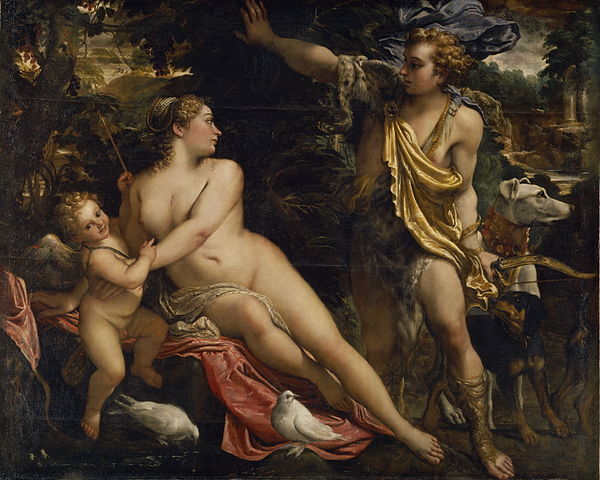
Title: Venus, Adonis and Cupid
Artist: Annibale Carracci
Date Painted: c. 1595
Period: Baroque
Location: Spanish Royal Collection
Summary of Venus, Adonis and Cupid
Venus, Adonis, and Cupid by Annibale Carracci is a renowned painting that beautifully encapsulates the themes of love, beauty, and tragedy through the lens of classical mythology. Created in the late 16th century, this work is a prime example of the Baroque period’s fascination with dynamic compositions, emotional depth, and the exploration of mythological subjects with a humanized sensibility.
The painting depicts the moment before the tragic hunting accident that leads to Adonis’s death, a story derived from Ovid’s “Metamorphoses”. Venus, the goddess of love, is shown trying to dissuade Adonis, her mortal lover, from going on a hunt, fearing for his safety. Cupid, the god of desire and affection, is also present, symbolizing the bond of love between Venus and Adonis. The inclusion of Cupid adds a layer of emotional depth, emphasizing the inevitability of their tragic fate.
Carracci’s portrayal of the figures is notable for its vitality and the sensuous interplay of light and shadow, which enhances the physical and emotional intimacy between Venus and Adonis. The figures are rendered with a remarkable attention to anatomical accuracy, draped in flowing robes that highlight their divine and mortal forms. The landscape in the background complements the scene, providing a lush, idyllic setting that contrasts poignantly with the impending tragedy.
One of the key features of this work is Carracci’s ability to convey the narrative’s emotional complexity. Venus’s expression is one of tender concern, capturing her deep love for Adonis and her foreboding of his fate. Adonis, on the other hand, appears determined yet unaware of the danger that awaits him, adding a layer of dramatic irony to the scene.
Venus, Adonis, and Cupid exemplifies Carracci’s mastery in blending the classical tradition with the Baroque era’s dynamism and emotional expressiveness. This painting is celebrated for its artistic excellence and its poignant depiction of love, loss, and the fleeting nature of beauty. Through this masterpiece, Carracci invites viewers to engage with the timeless themes of classical mythology, rendered with a newfound sense of immediacy and emotional depth.